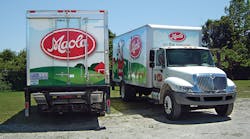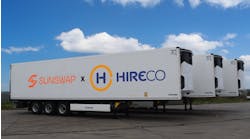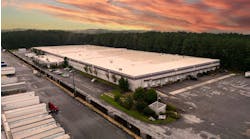Maola Milk and Ice Cream changes equipment, delivery methods for distribution efficiencies
When it Comes to spec'ing equipment, Maola Milk and Ice Cream Company focuses on making the driver's job easier. “We can't make milk any lighter,” says Dennis Lawrance, fleet manager of the New Bern, North Carolina-based dairy. “A gallon of milk isn't getting any lighter, nor is a case of ice cream. What we try to do is come up with better ways of delivering our products.”
Founded by the Mayo family in 1935, the company produces 48 flavors of ice cream, 33 varieties of milk, and five kinds of ice cream novelties. It also processes and packages various specialty products such as eggnog, as well as juices and water.
Starting with just a few horse-drawn carriages doing home delivery, Maola Milk and Ice Cream has 16 branches throughout North Carolina, South Carolina, and Virginia to service customers. These include convenience and grocery stores, schools, and institutional customers. It does this using a fleet of 165 straight trucks and six hotshot trucks, supplemented by a dedicated carrier with tractor trailers. The dairy has expanded numerous times to accommodate growth.
The transportation operation is divided into three distinct segments. Straight trucks with cold plate bodies for route delivery are stationed at branch locations. Six hotshot trucks are maintained for urgent deliveries. The dedicated carrier uses refrigerated tractor trailers to haul product from the dairy to the branches for route delivery.
In January 2003, the dairy was acquired by the Maryland & Virginia Milk Producers Cooperative Association. Headquartered in Reston, Virginia, the cooperative markets milk for more than 1,600 dairy farmer owners throughout the Mid-Atlantic and Southeast regions of the US.
Typically, with a change in ownership comes a change in how the acquired business is operated, and that has been the case at Maola Milk and Ice Cream. One area of change has been fleet standardization.
Product quality
Remaining steadfast, however, is the dairy's commitment and dedication to making premium milk and ice cream, says Lawrance, who was raised on a farm. Product quality control, processing, and distribution efficiency continue to be of utmost importance.
Product quality control starts with the cows at the farm and is controlled all the way through the quick process from the farm to the customer, he explains. “Because we're part of a farmer-owned cooperative, it's our farmers' cows. Our milk is trucked in by contract haulers from our coop dairy farms. We process it, package it, and ship it out of New Bern to customers quickly, ensuring freshness.
“That's why we must have dependable equipment, and why we've always had cold plate truck bodies,” says Lawrance. “Maintaining product quality and delivery deadlines can't be compromised.”
As the mixed fleet of route vehicles complete their lifecycles, they are being replaced with similarly spec'd equipment.
Uniform fleet
Lawrance has gone with International 4300 DuraStar conventional model trucks with a GVWR of 33,000 pounds. These are spec'd with a 255-hp International DT 466 diesel engine governed at 60 mph.
“The DuraStar is a driver friendly truck that's easy to operate,” he says. “It has a great ride and handling characteristics, plus it's easy for technicians to work on.”
Lawrance chose the DT 466 because “it's a proven, durable, long-life engine with a wet-sleeve architecture that makes it totally rebuildable in the chassis. The engine is pretty well goofproof for a long time.”
For the first time, Lawrance spec'd the route trucks with Allison automatic transmissions. This change was made because “today's automatics provide some advantages over manual transmissions, such as better fuel economy, increased productivity, and reduced maintenance. Our drivers really love them.”
The new standard insulated body for the fleet is a 20-foot cold plate body from Hercules Manufacturing. Designed with one curbside door and a sliding-swing combination rear door, the bodies are heavily insulated with 5 inches of polyurethane insulation in the floor and walls, plus 6 inches of polyurethane insulation in the ceiling.
Aluminum dairy flooring has been used for weight savings and to eliminate upkeep of older style steel treadplate floors. All hardware has been spec'd as stainless steel for reduced maintenance.
Each body is spec'd with three Grote LED interior lights, “which provide extremely bright light throughout,” notes Lawrance, and door activated light switches. The LED exterior lighting package includes a unique design of the rear top marker lights to provide an additional stop and turn feature for increased visibility and safety.
The Hercules Manufacturing bodies are upfitted with a 3,500-pound capacity Leyman LHLP Hide-A-Way liftgate with a large aluminum platform that tucks under the truck's rear.
“The nice thing about these liftgates is that they lower evenly to the ground so the loads remain stable,” Lawrance notes. “The platforms have a tapered lip so that hand trucks or carts can be easily rolled on and off.”
This body-liftgate combination “saves an overall vehicle weight of up to 1,800 pounds, depending on competitors' body styles,” adds Hercules Manufacturing sales manager James A “Chip” Honse Jr. “This can represent a significant annual savings in fuel costs, plus the extra savings of reduced wear and tear on the chassis components.”
Cold plates
Maola Milk and Ice Cream uses cold plate refrigeration systems because “they're much cheaper to operate and they last a lot longer,” says Lawrance. “Unlike mechanical refrigeration units, which have a lot of moving parts, cold plates have very few, so the reliability is improved for extended system life.
“With cold plates, you just have to plug them in. They're basically foolproof. We very seldom have problems with them.”
The cold plate system for the new Hercules Manufacturing milk body design is mounted on the front interior wall in a bank design with three circulating fans for better temperature recovery.
Basically, cold plate systems perform similarly to reusable ice packs for coolers, Honse explains. Frozen eutectic plates (reusable thermal accumulators) inside the body compartment absorb heat as a means of maintaining desired temperature levels. The plates are refrozen each day during a 10- to 12-hour electrical plug-in of the on-board compressor.
To increase the performance of the cold plate system, Maola has spec'd a sliding interior strip curtain that is adjustable to the size of the required milk compartment, reducing the space needed to be refrigerated as the load diminishes during the day.
Another performance enhancing feature added is an electronic auto-sequential defrost system that keeps the plates virtually frost free during a three-day cycle.
“For us, cold plate refrigeration has been cheaper to purchase, maintain, and operate than mechanical refrigeration systems,” says Lawrance, who has been with the dairy for nearly 19 years.
The cold plate bodies on the trucks Maola Milk & Ice Cream uses for ice cream deliveries are spec'd to go to minus 20• F. The milk trucks are spec'd to maintain 33• F.
Route truck chassis are typically kept for six years. Bodies are kept for 12 or more years.
Safety focus
Also for the first time, Lawrance is equipping all route and hotshot trucks with Safety Vision back-up camera systems to help drivers be more aware of unsafe conditions. The system is comprised of a small video camera mounted on the top rear of the body. Its wide field of view is displayed on a cab-mounted monitor.
“Adding the back-up cameras is just another extension of our safety focus,” he says.
“Safety is very important here at Maola. We eat, sleep, and live safety. We hold monthly safety meetings for everyone — not just drivers.”
Along with comprehensive incentive programs that reward safe driving, the dairy has been a long-time user of the SafetyFirst driver monitoring system. Every vehicle and trailer displays a decal with an individualized identifying number, asking motorists to report unsafe driving practices or equipment.
“All calls are followed up by our safety director, Sue Shivar,” says Lawrance. “She makes sure corrective action is taken and drivers are given any needed coaching.”
Shuttle operation
Years ago, Maola Milk and Ice Cream used to operate a fleet of 20 three-axle daycab tractors and 60 refrigerated trailers. They were used to transport product from the New Bern plant to branch locations where the product is put into cold storage until loaded onto route trucks for customer deliveries.
It sold its tractors to Dairy Moovers, which operates next door and has the company handle the shuttle operations. This was done to better focus on route operations and to gain some efficiency.
Lawrance is standardizing the fleet's refrigerated trailers. As trailers are cycled out, they are being replaced with Hyundai Translead 47-foot HT ThermoTech refrigerated trailers with Carrier Transicold Ultra XL refrigeration units with electric standby.
The HT ThermoTech was chosen because of its “superior appearance” and heavy-duty design that provides greater durability and extended service life, says Lawrance. The Ultra XL refrigeration units were spec'd because of their reliability and temperature control with minimum service and maintenance. Plus, the built-in electric standby capability allows the unit to operate without having to run the diesel engine.
“By next year, we will have replaced most of our old trucks and trailers with new ones,” says Lawrance. “It's been a very challenging process.”
Maintenance programs
The dairy has a four-bay shop and four technicians. Most of the maintenance and service work is done on-site. At the branches, repair work is jobbed out. However, preventive maintenance is done by a technician from the plant in a dairy-owned service truck that visits each branch on a regular schedule.
Every three months, all trucks go through an all-inclusive preventive maintenance where everything is inspected, including all safety equipment, Lawrance says. Particular attention is paid to the curtain material, and all doors are checked for tightness. “Every little bit helps.”
Maola Milk & Ice Cream has fuel tanks on premises for reefer fuel and diesel fuel that it sells to Dairy Moovers. The dairy's trucks fuel on the road using a nationwide commercial network of fueling locations linked to an electronic purchasing, management, and reporting system.
Delivery procedures
Loading of trailers is done at a four-door loading area. Crates of stacked product are loaded onto a chain-drive floor conveyor that moves product to the appropriate trailers. There, a pushing machine drives the stacks into the trailer. Each stack is distributed evenly for delivery by loaders, then, secured for transport.
Three dairy-owned Capacity yard trucks shuffle trailers to and from the loading docks and the secured truck parking area.
Route trucks are loaded from a separate loading dock area. Drivers load their own trucks for the next day's delivery at the end of each day's run. Orders are pulled for the drivers and stored in a large cooler behind the loading area.
Route deliveries, many of which run six days a week, usually start between 4 and 5 am. Most customers have time-windows for scheduled deliveries.
“Our drivers, who we refer to as RSRs (route sales representatives), are assigned to routes,” says Lawrance. “This helps them get to know their customers, and that speeds up the delivery process.”
At one time, the dairy had independent contractor routes to handle certain geographical areas it didn't serve, but not anymore.
There are about 200 RSRs, including supervisors and relief drivers. The dairy has about 340 employees.
Because of the special nature of milk and ice cream trucks, the dairy maintains a number of spares of each type at branches just in case they are needed. “You can't just call up a truck rental company and find one of these trucks.”
Also new to the Maola Milk & Ice Cream fleet are six Ford F350 Super Duty pickup trucks with 8-foot slip-in insulated bodies from Hercules Manufacturing and Carrier Model Integra 40X refrigeration units that work off the truck engine.
These trucks, which can hold up to 85 cases of product, are used for emergency orders or for customers who have forgotten to order needed items.
The dairy also updated the mascot, Mooella, giving her a makeover into a “modernized,” friendly character, says Lawrance. Mooella is included on the new, brighter graphic designs for the fleet.
Driver issues
Driver recruiting and retention is not usually a problem at Maola Milk and Ice Cream, says human resources manager David Briley. “This is a good place to work and we treat our people well. There are opportunities for drivers to earn a good income and have a lot of independence.
“Working a route is like working for yourself. That's really the concept behind our routes,” he says. “Drivers are paid a base wage, plus commissions on their sales, with incentive bonus opportunities as well.”
When hiring (route sales representatives), the dairy seeks to find applicants who will be a good fit. Briley looks for someone who has a clean CDL and no criminal record and isn't afraid to work. Beyond that, he wants a “people person” who has good customer service skills and can handle frustration.
“The biggest reason people don't make it in route work is because it requires a lot of patience,” he observes. “Route salespeople have to deal with all types of customers, including those who are very busy and often agitated, as well as deal with the pressure of meeting store cutoff times and factors beyond their control, such as traffic and weather.
“The best route drivers understand that if the truck breaks down or the weather is bad, the day is going to be longer. They don't look at their watch. They quit rushing, do what needs to be done, and just roll with the flow.”
Some RSRs have been with the dairy 30 and 40 years.
Maola Milk & Ice Cream distinguishes itself from other brands, says Lawrance, because of a close relationship with dairy farm owners and a commitment to product quality. Freshness is assured because the modern, dependable fleet quickly and efficiently gets products to customers.
This formula works, as the business continues to grow within and beyond traditional service areas of North Carolina, South Carolina, and Virginia.



